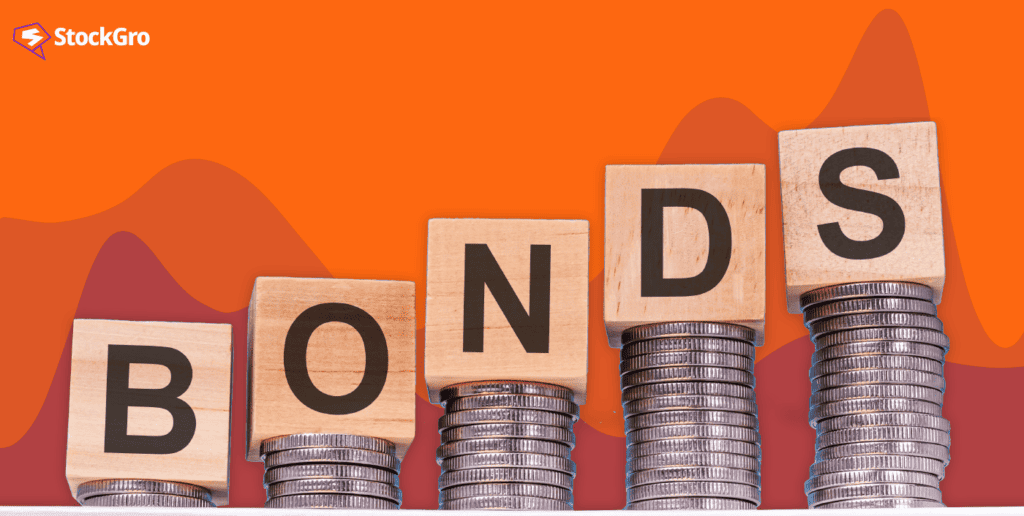
When borrowing money, there’s more than just asking the bank for a loan. Enter bonds! Bonds are like the secret agents of the finance world, helping corporations, governments, and other big borrowers secure funds for their current and future endeavours.
What is a bond?
At its simplest, a bond is like an IOU ( a written acknowledgement to repay a debt). When you buy a bond, you’re essentially lending money to the issuer in exchange for regular interest payments and the return of the principal amount at a later date.
Think of it like this: you’re the investor, and the borrower is your friend. Your friend promises to pay you back the loan amount with a little extra interest. A bond works similarly, except the borrower is a company or government.
Bonds are like rock-solid debt instruments representing loans made to borrowers. Now, let’s meet the main players:
You may also like: Why did Pakistan’s rupee, & bonds plunge to record low after Imran Khan’s arrest?
Who issues bonds?
Who are the secret agents behind the scenes issuing these intriguing bonds, and why do they issue them? Let’s find out!
The issuers of bonds can be divided into two main categories: government and corporations.
Government: Funding the future
Governments, our very own rulers, play a significant role in the world of bonds. They need funds to sponsor grand projects like building roads, schools, dams, and other essential infrastructure.
Corporations: Fueling business growth
Now, let’s shift our focus to the corporate world. Businesses and corporations often need funds to fuel their growth and advance their ventures. Banks can only lend so much, but the world of bonds opens up a whole new realm of possibilities.
How do bonds work?
Bonds have three vital components that shape their existence. Let’s break them down into bite-sized pieces:
- The Principal: Face value is also known as principal, nominal, or par value. It represents the amount the issuer is legally obligated to return to the investor after a specific period.
Remember that a bond’s face value may differ from its market value, which can fluctuate based on market conditions and investor demand.
- Interest or Coupon Rate: This refers to the fixed or floating rate of interest that a bond accrues over time. It is payable periodically to creditors. The interest earned on a bond depends on various aspects, such as tenure and
the issuer’s reputation in the public debt market.
- Tenure of Bonds: This is the period after which the bond matures. An issuer’s financial and legal obligations to the investor or creditor are valid only until the tenure’s end.
Also Read: Indian Origin Ajay Banga takes on the World Bank presidency
Credit quality and Tradability
When it comes to bonds, trust is everything. A bond’s credit quality reflects investors’ confidence in an organisation’s long-term performance. Let’s uncover more:
Credit rating agencies evaluate companies and assign risk grades to their bonds. It’s like having inspectors in the bond universe.
Investment-grade securities are susceptible to lower yields due to a steady market risk factor, whereas non-investment grade securities offer high returns at considerable risks.
Bonds are tradable in the secondary market. The ownership can shift among various investors within the tenure.
The market price of a bond depends on a number of factors: the credit quality of the issuer, the tenure of time until expiration, and the coupon rate compared to the general interest rate environment at the time.
What are the different bond categories?
Just like a box of chocolates, bonds come in various flavours. Let’s break them down and see what makes each one special:
- Callable bonds
When a bond issuer has the right to redeem the bond before it reaches maturity, it’s called a callable bond. This option is exercised by the issuer. Why would they do this? Well, they can convert a high-debt bond into a low-debt bond. Sneaky, huh?
- Fixed-rate bonds
Fixed-rate bonds have a coupon rate that remains unchanged throughout the investment period. This means that investors can enjoy predictable returns on their investments.
- Floating-rate bonds
The coupon rate for floating-rate bonds varies during the investment period depending on market conditions. This means that returns on investment through interest income can be inconsistent.
- Zero-Coupon bonds
Zero coupon bonds have a zero coupon rate, meaning that the bond issuer only pays the principal amount to the investor on maturity.
- Puttable bonds
Puttable bonds allow investors to sell their bonds and get their money back before maturity.
- Inflation-linked bonds
Inflation-linked bonds are designed to curb the impact of economic inflation on the face value and interest return. These bonds adjust coupons concerning prevailing rates in the debt market.
- Perpetual bonds
Perpetual bonds are fixed-security investment options that do not have a maturity period. Investors benefit from steady interest payments for perpetuity.
What are the different types of bonds?
Bonds come in all shapes and sizes, and each type offers different features and risks. Here’s a breakdown of the most common bond types:
1. Government bonds
- As the name suggests, these bonds are issued by the Indian government to finance its operations. They’re generally considered low-risk, as they’re backed by the government’s ability to tax its citizens to repay the bonds.
2. Corporate bonds
- Corporate bonds are issued by private companies to raise capital at a low-interest rate. They offer higher yields than government bonds but come with greater risk, as companies can default on their payments if their business runs into trouble.
- There are two types of corporate bonds – secured and non-secured. Secured bonds are backed by collateral, which means that if the company defaults, the bondholders can claim the collateral. Non-secured bonds are not backed by collateral.
3. Municipal bonds
- They are issued by local governments to fund public projects like schools, roads, and hospitals. They’re similar to government bonds in that they’re backed by the government’s ability to raise taxes, but the interest earned on these bonds is typically tax-free.
4. Asset-Backed Securities
- Asset-Backed Securities are a type of bonds that are issued by banks or other financial institutions. These bonds are backed by assets such as mortgages, auto loans, or credit card debt. They can offer higher yields than government bonds but are also riskier, especially during economic downturns.
Also Read: A guide to value investing in India
Benefits of bonds
Investing in bonds has its perks. Let me break it down for you:
Stability
- Bonds are like that reliable friend who always has your back. They provide a stable investment option because you can count on receiving regular interest and principal payments.
Indentures
- These indentures legally bind borrowers to return the principal amount to the creditors on time. So, you can sleep easy knowing that you’re protected by the power of contracts!
Portfolio diversification
- Think of bonds as your secret weapon for diversifying your investment portfolio. Adding fixed-income debt instruments like bonds to your mix can achieve superior risk-adjusted returns.
Risks of bonds
Bonds are not all sunshine and rainbows. They come with their fair share of limitations. The not-so-glamorous side of bonds!
Low returns
- Okay, let’s address the elephant in the room. Bonds typically provide lower returns than stocks. It’s like opting for a smaller slice of the investment pie. But hey, a smaller slice is better than no slice at all, right?
Interest rate risk
- When interest rates rise, bond prices fall. Ouch! This can hurt investors if they need to sell their bonds. It’s like getting caught in a sudden downpour without an umbrella.
Inflation
- Inflation can be a sneaky little troublemaker. As prices increase, your fixed interest payments’ purchasing power decreases. Imagine your money shrinking like a deflating balloon. Not cool, right?
Illiquidity
- Bonds are like the introverts of the investment world. They can be less liquid than stocks, meaning they might not be easy to sell at a desired price. It’s like selling a rare collector’s item without finding the right buyer.
And there you have it, a guide to the fascinating world of bonds! Now that you know the ins and outs, it’s time to open up your financial options and dive into the bond market. Who knows? You might just become a bond aficionado in no time!

